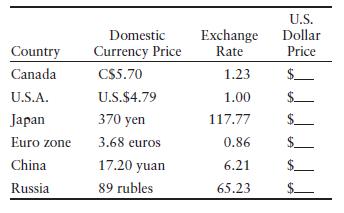Every few months, The Economist publishes its Big Mac Index. Using the current exchange rates, it compares
Question:
Every few months, The Economist publishes its “Big Mac Index.” Using the current exchange rates, it compares the U.S.-dollar price of Big Macs in several countries. It then concludes that countries in which the Big Mac is cheaper (in U.S. dollars) than in the United States have “undervalued” currencies. Similarly, countries with Big Macs more expensive than in the United States have “overvalued” currencies. The table below shows data from January 2015. (Data from www.economist.com .) It shows the domestic-currency prices of Big Macs in various countries. It also shows the exchange rate, expressed as the number of units of domestic currency needed to purchase one U.S. dollar.

a. For each country, use the exchange rate provided to convert the domestic-currency price to the U.S.-dollar price. The price in terms of the currency for any country i is Pi = e × PU.S..
b. By the logic used in The Economist , which currencies are overvalued and which are undervalued relative to the U.S. dollar?
c. Are Big Macs traded goods? If not, does this present a problem for The Economist ? Explain.
d. Which of the following goods do you think would be a better candidate for this exercise? Explain your choice.
(i) cement
(ii) diamonds
(iii) fresh fruit
(iv) computer RAM chips
Step by Step Answer:






